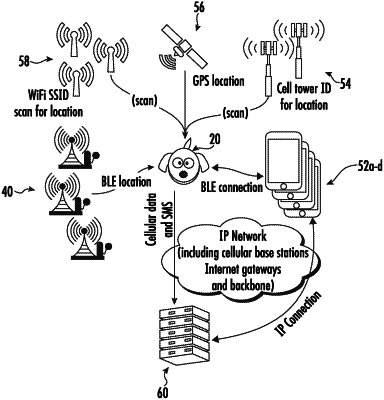| CPC A01K 27/009 (2013.01) [A01K 11/008 (2013.01); A01K 15/021 (2013.01); A01K 27/001 (2013.01); A01K 29/005 (2013.01); H04W 4/023 (2013.01); H04W 52/0251 (2013.01); H04W 88/04 (2013.01); Y02D 30/70 (2020.08)] | 20 Claims |

|
1. A method for monitoring an animal with an animal collar system comprising a user device associated with a user, a base station, and an animal collar device, the method comprising:
collecting data about the animal with at least one monitoring component in the animal collar device;
communicating the data about the animal to the base station and the user device with a plurality of communication components in the animal collar device, the plurality of communication components comprising a first local transceiver, a second cellular network transceiver, and a geolocation receiver; and
operating a processor in the animal collar device and coupled to a battery to
selectively enable the first local transceiver to initially determine whether the first local transceiver is directly connected to the user device to provide a location of the animal relative to the user device,
when not directly connected to the user device and using the first local transceiver, determine whether the first local transceiver is directly connected to the base station to provide a location of the animal relative to the base station,
based upon the location of the animal relative to the user device and the location of the animal relative to the base station, cause the animal collar device to enter one of a plurality of communication states, the plurality of communication states comprising
a together state when directly connected to the base station and the user device, or when directly connected to the user device,
an away alone state when not directly connected to the base station and the user device, and
a home alone state when directly connected to the base station and not directly connected to the user device, and
when in the away alone state, selectively enable the geolocation receiver and the second cellular network transceiver to transmit the data about the animal via an external cellular network.
|